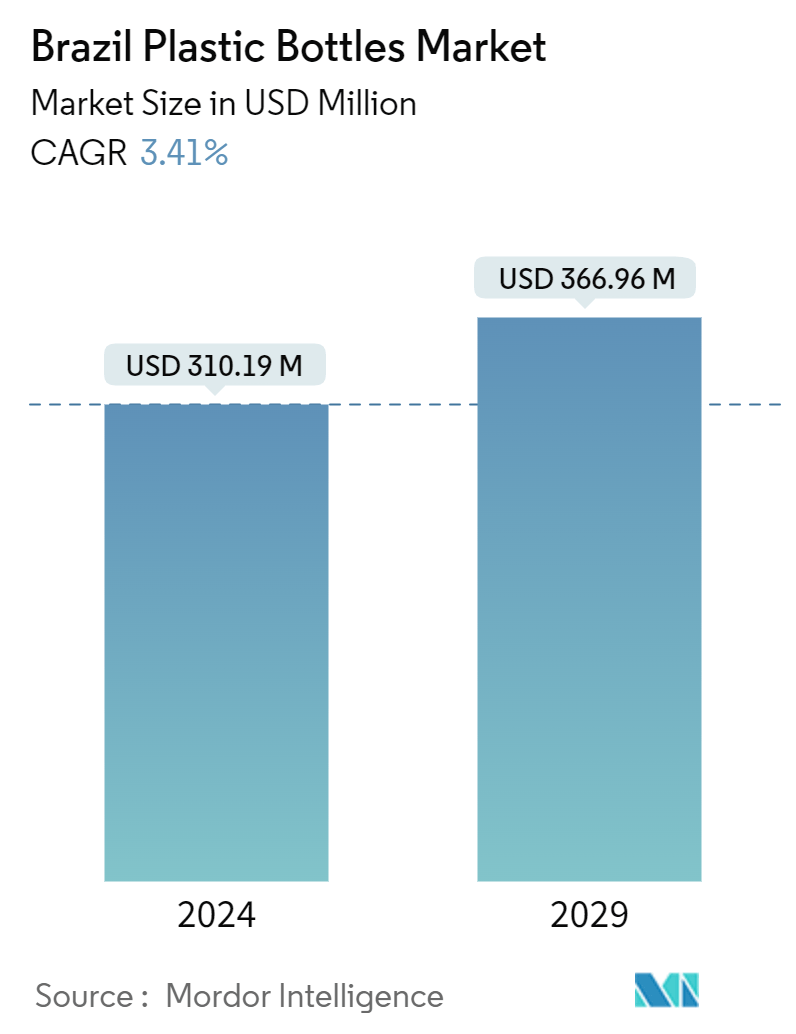
| Study Period | 2019 - 2029 |
| Base Year For Estimation | 2023 |
| Forecast Data Period | 2024 - 2029 |
| Market Size (2024) | USD 310.19 Million |
| Market Size (2029) | USD 366.96 Million |
| CAGR (2024 - 2029) | 3.41 % |
| Market Concentration | Low |
Major Players.webp)
*Disclaimer: Major Players sorted in no particular order |
Brazil Plastic Bottles Market Analysis
The Brazil Plastic Bottles Market size is estimated at USD 310.19 million in 2024, and is expected to reach USD 366.96 million by 2029, growing at a CAGR of 3.41% during the forecast period (2024-2029). In terms of production volume, the market is expected to grow from 335.05 thousand tonnes in 2024 to 393.23 thousand tonnes by 2029, at a CAGR of 3.25% during the forecast period (2024-2029).
- Plastic packaging has gained significant popularity among consumers in Brazil compared to other materials due to its lightweight and durable nature, which enhances ease of handling and transportation. Major manufacturers also prefer plastic packaging because of its lower production costs and versatility in design. Furthermore, the introduction of advanced polymers like polyethylene terephthalate (PET) and high-density polyethylene (HDPE) has substantially expanded the applications for plastic bottles across various industries, including food and beverage, personal care, and household products. The market has experienced a notable increase in demand for PET bottles, driven by their recyclability, clarity, and barrier properties. This trend is further supported by the growing consumer awareness of environmental issues and the subsequent demand for more sustainable packaging solutions.
- Plastic bottles and containers, primarily made of polyethylene terephthalate, polypropylene, and polyethylene, are widely used due to their lightweight properties and recyclability. These characteristics make plastic the preferred choice among end-users in various industries, including food and beverage, personal care, and household products. The cost-effectiveness of plastic materials is a significant factor driving their adoption. In addition, the increasing global consumption of packaged and processed foods and the growing demand for bottled beverages are expected to fuel market growth. The versatility of plastic packaging, its ability to extend product shelf life, and its convenience for consumers further contribute to its popularity.
- Brazil has experienced improved economic growth and significant demographic changes that have influenced the region's development. The expansion of organized retail, including supermarkets and hypermarkets, has increased the demand for plastic bottles. These outlets require extensive packaging to cater to diverse consumer needs, driving overall market growth. The trade scenario has evolved in recent years. As imports and exports in the region have grown, there has been a corresponding increase in demand for packaging that meets international standards. This demand is driven by the necessity for plastic bottles to comply with global packaging requirements and ensure the quality of exported products.
- An expanding array of applications across various regional industries drives the market's growth. In the pharmaceutical sector, plastic bottles are a dependable packaging choice for tablets, syrups, and capsules, thanks to their moisture-resistant properties that ensure product stability. For instance, Berry Global Healthcare is launching a comprehensive solution to help clients tap into the surging demand for child-resistant (CRC) and tamper-evident (TE) packaging in the pharmaceutical and herbal sectors, specifically for syrups and liquid medicines. Leveraging its extensive design and technical expertise in healthcare, the company offers a diverse range of bottle and closure solutions tailored to market needs.
- While Brazil has not implemented a nationwide ban, key local governments such as the State of Rio de Janeiro and the City of São Paulo have adopted bans on plastic packaging and other single-use plastic products. Companies have begun to adapt quickly, working to measure plastic footprints, introduce new products with recycled plastic (rPET), set ambitious yet achievable targets, and implement changes to packaging supply chains. For instance, Valgroup has acquired the PET bottle recycling activity of 3 Rios Fibras e Resinas in Poços de Caldas, Minas Gerais. The company is investing in expansion, increasing its installed capacity to produce food-grade rPET (recycled PET resin). This recycling process, known as bottle-to-bottle, transforms post-consumer PET bottles into new ones ready for filling. Valgroup's PET recycling plants, located in Brazil, Mexico, and Spain, process a total of 145,000 tons of post-consumption recycled resin annually.


